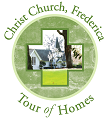|
History of Area and Parish
SAINT SIMONS ISLAND/ GLYNN COUNTY,
GEORGIA
In the 17th century, European missionaries arrived in hopes of bringing
Christianity to the inhabitants of the area. However, they met with great
resistance from the natives and soon left their settlement, which was initially
called San Simeon.
In 1736, English settlers, led by General James Edward Oglethorpe,
established a colony and fortification at Fort Frederica, just a stone’s throw
from the site of today’s Christ Church, Frederica. These Englishmen engaged in
many battles against Spanish invaders, the most deadly being the Battle of
Bloody Marsh. Against strong odds, the British troops were able to hold the fort
and township of Frederica.
After the establishment of the 13 colonies, a great number of English
loyalists returned to their homeland. However, many determined pioneers stayed
or headed north to fight the British troops. John and Charles Wesley, founders
of the Methodist Church, arrived in 1736 and, under the massive oak trees,
preached to the natives and established a congregation at Frederica, the
predecessor of Christ Church. Plantation life began when it was discovered that
the soil in this area was very fertile and could grow many diverse crops, one of
which was a special strain of cotton that became known as Sea Island cotton. It
was in high demand worldwide and, as a result, many slaves were brought from
Africa to tend the fields. In fact, several of their direct descendants still
live on St. Simons today.
After the Civil War, life on the plantation drastically changed. The land had
been neglected and the slaveshad been emancipated. Many of the plantation owners
left to begin their lives anew elsewhere.
In the years following the Civil War, some of the plantation owners moved to
Brunswick, former residents returned to the area, and the port town began to
grow. Brunswick became a busy shipping center, and industries connected to
lumber and naval stores became established. The mild climate attracted visitors
to the town, which by 1880 had two railroads, an excellent harbor and a new
hotel. On St. Simons Island, the property of Hamilton Plantation, on a bluff
overlooking the marshes and the mainland, became a busy sawmill. Boat service
between Brunswick and the island brought supplies, mail and visitors, including
The Reverend Anson Dodge, Jr., who stayed, built the present Christ Church,
Frederica, and became its rector. By the turn of the century, summer visitors
were beginning to come regularly to St. Simons Island, and it soon became one of
the favorite resorts in Georgia.
Today, St. Simons Island, Sea Island, Jekyll Island, Little St. Simons Island
and the mainland are often referred to as Brunswick and the Golden Isles. The
climate is moderate and the area is blessed with sandy beaches, ocean breezes,
beautiful marshes and towering oaks. Tourism is a major industry in the area,
and many newcomers arrive each year to make their homes.
The local Chamber of Commerce has a visitors’ guide that you may want to
peruse. It gives a more detailed view of this beautiful area of coastal Georgia
and its rich history. You may also want to check the Chamber’s website at
www.brunswick-georgia.com.
Parish History
The church traces its origin to General James Oglethorpe’s landing with the
first English settlers on St. Simons Island on February 22, 1736. After
breakfast, a group assembled and joined in reading the Litany with The Rev.
Benjamin Ingham. General Oglethorpe had established the first English colony in
Savannah and settled this second colony at Frederica to protect the new colony
of Savannah from the Spanish threat in Florida.
Three outstanding religious leaders of the 18th century were associated with
the establishment of the church on St. Simons Island. The Rev. Charles Wesley,
MA, entered his ministry at Frederica on March 9, 1736, two weeks after the
landing of the first settlers. He served as Chaplain to General Oglethorpe and
as Secretary for Indian affairs. Services were also conducted by The Rev. John
Wesley, The Rev. George Whitefield and other clergy appointed by the Society for
the Propagation of the Gospel. These ministers were ordained clergymen of the
Church of England by whom the Episcopal Church in the United States was planted
and nurtured. After the return of the Wesleys to England, the evangelical
revival eventuated in the origin of the Methodist Church in which John Wesley
had the principal role.
In 1752, the Trustees surrendered their Charter to the King, and Georgia
became a Royal Colony. In 1758, the Province was divided into parishes, and
Frederica and St. Simons were designated as St. James Parish.
Following the Revolutionary War, the descendants of early settlers petitioned
for a charter and were incorporated by an act of the State Legislature on
December 22, 1808, as "The Episcopal Church in the Town of Frederica," called
Christ Church. Land from the town of Frederica was also "Given, Granted and
Secured To and For the Use and Benefit of the Said Episcopal Church."
The first church on the present location was erected in 1820, and the
congregation worshiped in it until the outbreak of the Civil War. The Reverend
Edmund Matthews, DD, who became rector in 1810, was one of three clergymen
composing the Primary Convention for the organization of the Diocese of Georgia
in 1823.
The Rev. Anson Green Phelps Dodge, Jr., rebuilt the church following its
destruction during the Civil War as a memorial to his first wife, Ellen. The
church was consecrated on the Feast of the Epiphany in 1886 by the Rt. Rev. J.
W. Beckwith, DD, Bishop of Georgia. In addition to establishing an endowment for
Christ Church, Frederica, Mr. Dodge built and endowed the Anson Dodge Home for
Boys (closed in 1956), and established the Georgia Missions Fund for the support
of missionaries and teachers in certain designated counties of the Diocese. This
legacy still provides college scholarships for young men in the Diocese of
Georgia.
The present church building is cruciform in design with a trussed Gothic
roof. Stained glass windows, given as memorials, commemorate events in the life
of Christ and the early history of the church on St. Simons Island. The Font was
given to the church by the Sunday School of St. Thomas Church, New Haven,
Connecticut, in 1884. Part of the Credence Table and an inset in the present
altar are from the altar of the 1820 church.
In the surrounding churchyard are buried former rectors of the church, early
settlers and their families, people who lived in the plantation era and island
residents and church members from the early days of the 19th century to the
present. Georgia’s first State Historian, Lucian Lamar Knight, is buried here.
The oldest gravestone that has been discovered dates from 1803.
St. Ignatius Church, located on Demere Road near the causeway to Brunswick,
was erected in 1886 and serves today as a chapel of Christ Church, Frederica
with services held there regularly. Both churches are built of heart pine lumber
produced at the island’s 19th century lumber mill located on the banks of the
Frederica River at Gascoigne Bluff, now the location of Epworth-by-the-Sea, a
camp and conference center of the United Methodist Church.
CLERGY HISTORY
THE MISSION, 1736-1766
|
The Reverend Charles Wesley |
1736 |
|
The Reverend John Wesley |
1736 -1737 |
|
The Reverend George Whitefield |
1737 -1738 |
|
The Reverend William Norris |
1740 -1741 |
|
The Reverend Thomas Bosomworth |
1743 -1745 |
|
The Reverend Bartholomew Zoaberbuhler |
1746 -1766 |
THE PARISH INCORPORATED, DECEMBER 22, 1808
| The
Reverend Dr. William Best, Rector |
1808
-1810 |
| The
Reverend Dr. Edmund Matthews, Rector |
1810
-1827 |
| The
Reverend T. C. Elliott |
1826 |
| The
Reverend T. S. W. Motte, Rector |
1828
-1830 |
| The
Reverend T. B. Bartow, Rector |
1830
-1841 |
| The
Reverend Edward T. Walker, Rector |
1842
-1844 |
| The
Reverend Edmund P. Brown, Rector |
1844
-1868 |
THE PARISH REORGANIZED, 1879
| The
Reverend Henry E. Lucas, Priest-in-Charge |
1882
-1884 |
| The
Reverend Anson Green Phelps Dodge, Jr., Rector |
1884
-1898 |
| The
Reverend D. Watson Winn, Rector |
1898
-1923 |
| The
Reverend Dr. Charles Lee, Rector |
1923
-1938 |
| The
Reverend Joseph Walker, Rector |
1938 |
| The
Reverend J. Sullivan Bond, Vicar |
1938
-1942 |
| The
Reverend Frederick Cousins, Supply Priest |
1942
-1953 |
| The
Reverend Wiltshire W. Williams, Rector |
1945
-1946 |
| The
Reverend Lawrence M. Fenwick, Rector |
1946
-1947 |
| The
Reverend Dr. Edwin Bethea, Rector |
1947
-1953 |
| The
Reverend Dr. Junius J. Martin, Rector |
1953
-1978 |
| The
Reverend William Thomas Fitzgerald, Rector |
1978
-1992 |
| The
Reverend Canon Douglas Renegar, Rector |
1992
-2004 |
| The
Reverend Curtis F. Mears, Priest-in-Charge |
2004
-2006 |
| The
Reverend Ladson Mills, Rector |
2006-2010 |
|
The Rev. Stephen D.
McWhorter Interim Rector. |
2010-2013 |
| The
Reverend Thomas Purdy, Rector |
2013- Present |
|

